Funnel clouds spotted near Henderson and New Prague.
1.75" diameter hail reported near Blakely, Minnesota at 3:20 pm Saturday.
Slight severe storm risk: southwestern third of Minnesota later today.
Monday threat: severe storms are most likely west of the Twin Cities metro area PM hours.
80s to near 90: possible next weekend as a summerlike airmass finally surges into Minnesota.
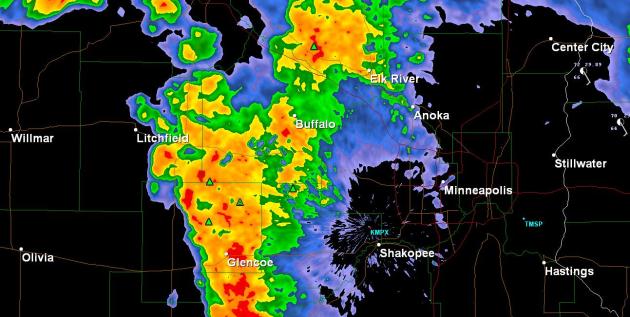
Supercell. Here is a NWS Doppler image taken around 2:40 pm Saturday, showing a hook echo just east of Gaylord, the cell that spawned a possible tornado just west of Gaylord.

Tornado Touchdown? Those little green dots are reports of large, damaging hail from the "supercell" thunderstorm that formed over the far southern suburbs Saturday afternoon. Reports of 1-2" hail were fairly common. At 2:38 there was a report of "debris" just west of Gaylord, Minnesota - it may have been a brief tornado touchdown. Funnels were spotted near Henderson and New Prague.
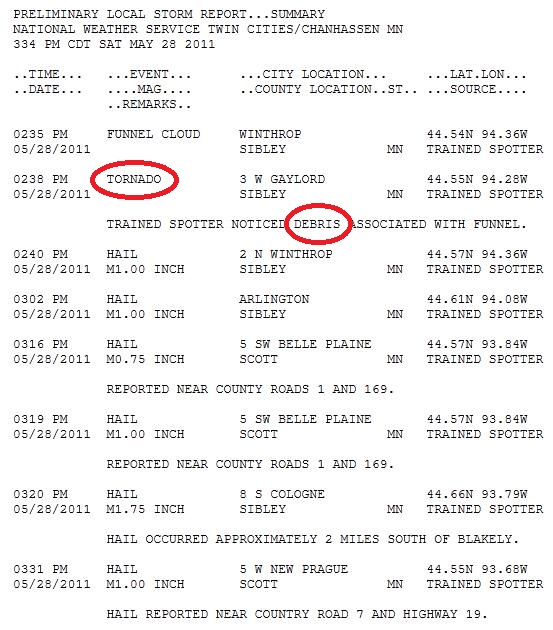
Storm Reports. Here is a list of large hail - and the possible tornado near Gaylord. More details here.
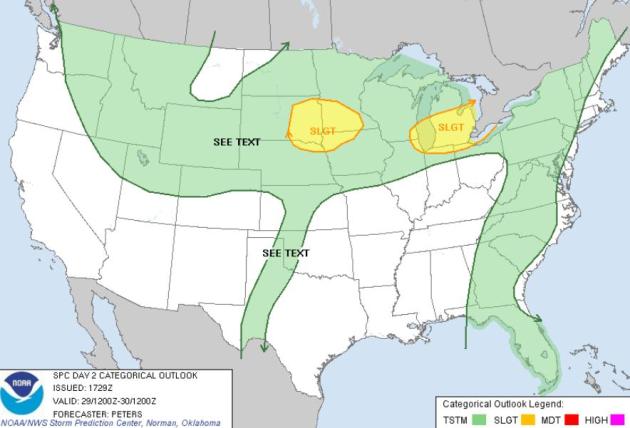
Sunday Severe Risk. SPC has expanded the slight severe threat into much of southern and central Minnesota later today. The best chance of hail and damaging winds will come late afternoon and evening hours, especially south/west of the Minnesota River. An isolated tornado can't be ruled out (because of very strong "shear" values - strong winds overhead changing direction/speed with altitude).
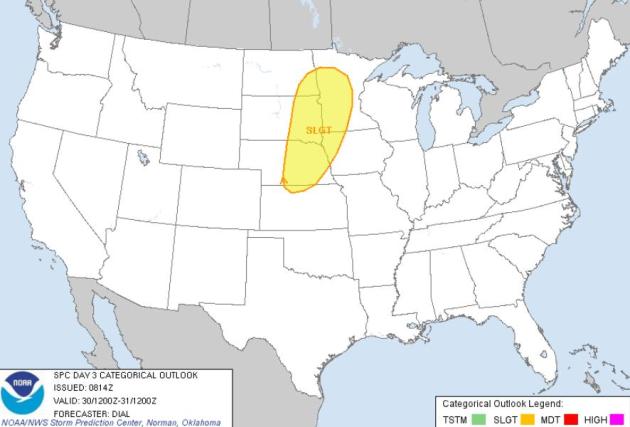
Memorial Day Tornado? Good grief - I guess you could have predicted this months ago. The good news: it will be warm enough for the lake - highs surging into the 80s over central and southern Minnesota. The bad news: conditions may be ripe for a few severe storms again Monday - hail, damaging straight-line winds, even a few (isolated) tornadoes can't be ruled out. MOST of us will see a generic thunderstorm, any severe weather will affect a tiny percentage of the state. That said, there's no way (in advance) to pinpoint which towns may be hit. You'll want to stay alert Sunday, again Monday, especially afternoon and evening hours.
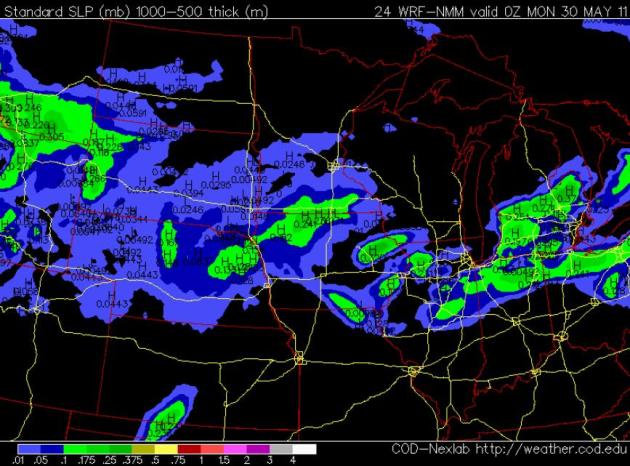
Sunday Evening. Much of northern Minnesota may miss out on the T-storms later today, the best chance of strong to severe storms south of the metro area. NAM model output valid 7 pm Sunday evening.

Instant Summer Next Weekend? The GFS model is hinting at upper 80s for the metro area next Saturday & Sunday, June 4 and 5. Finally, some truly lake-worthy weather (hopefully without any severe storms).
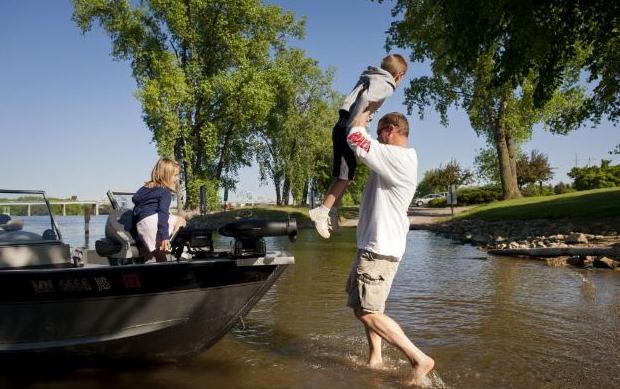
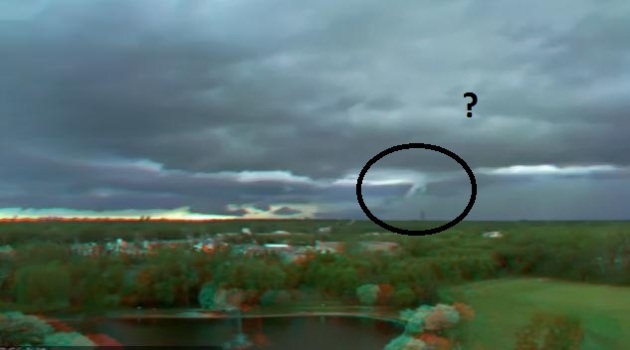
3-D Storm Time Lapse From Last Sunday's Tornado in Minneapolis. Check out this (3-D) time lapse on YouTube. Not sure if this guy accidently caught a developing tornado - it may just be scud, but the timing was quite remarkable: "Filmed from Plymouth, MN near 169/55 facing West. Around 1:15 there appears to be a tornado trying to form. Filmed on two Logitech C910 webcams about 12 feet apart. Music "Grow Without You" by Mua & Shaun.
* Now, if I can just find my geeky 3-D glasses I'll be able to watch this the way it was meant to be viewed.
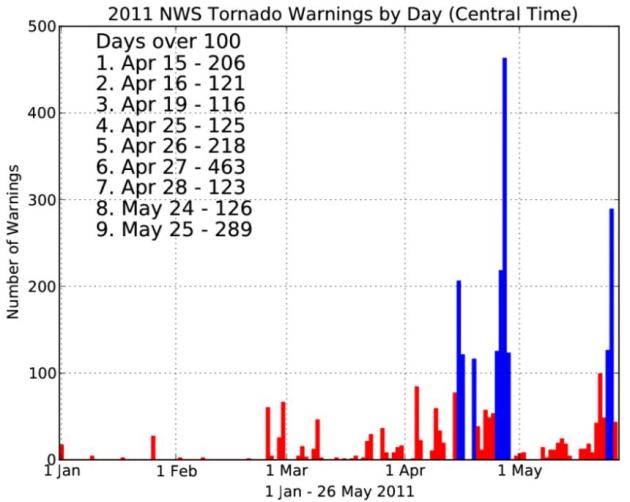
9 Days Over 100 Warnings. The Iowa Environmental Mesonet has an update on the number of tornado warnings in the USA, to date: "The featured chart displays the number of tornado warnings issued by the NWS for each day this year. There have been 9 days with over 100 warnings issued per day. In total, there have been 3,147 tornado warnings issued so far this year. This total is only about 300 warnings shy of the entire year's total for 2010."
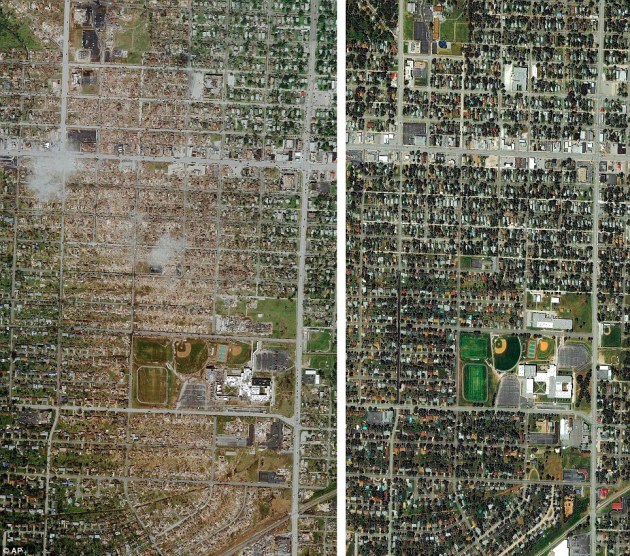
Tornado Statistics. Figures about the tornado that ripped through Joplin, Mo., on Sunday and the 2011 tornado season. All "record" statistics represent the official record of the National Weather Service, which covers 1950 to present day. Data courtesy of the Associated Press, thanks to Chad Merrill from Earth Networks (formerly WeatherBug) for passing this along:
JOPLIN TORNADO
- People killed: 132.
- Injured: More than 900.
- Unaccounted for: 156. Authorities believe most are safe and are urging those named to check in with authorities.
- Buildings destroyed: An estimated 8,000.
- About the tornado: Deadliest single tornado since records began in 1950. Storm Prediction Center says unofficial records show last single tornado with greater death toll occurred in 1947. National Weather Service rated the storm an EF5, the highest rating based on inflicted damage. Winds exceeded 200 mph.
TORNADO COUNT
- Tornadoes to strike Joplin: 1.
- Preliminary tornado reports made so far in the U.S. in May: 292, through May 27.
- Average number of tornadoes in May during the past decade: 298.
- Record for tornadoes in May: 542, in 2003.
- Preliminary tornado reports made so far in the U.S. in 2011: 1,333, through May 27.
- Average number of confirmed tornadoes in a single year during the past decade: 1,274.
- Highest recorded number of confirmed tornadoes in a single year: 1,817, in 2004.
WATCHES AND WARNINGS:
- Total severe weather watches issued since Sunday by the NWS's Storm Prediction Center: 68.
- Total tornado watches issued since Sunday by the NWS's Storm Prediction Center: 33.
- Total severe weather warnings issued since Saturday by local NWS offices: More than 2,500.
- Tornado warnings issued since Saturday by local NWS offices: More than 600.
DEATH TOLL
- People killed in Joplin tornado: 132.
- People killed in Oklahoma from storms this week: 10.
- People killed in Kansas from storms this week: 2.
- People killed in Arkansas from storms this week: 4.
- People killed in 2011 prior to Joplin tornado: 365.
- People killed in 2011, as of May 26: 513.
- Highest recorded death toll in a single year: 519, in 1953.

Melon-Size Hail? Yes, this would really sting. At this rate we'll all be walking around with football helmets on to mow the lawn any day now. More from Yahoo News: "Melon-sized hail that fell during a severe thunderstorm in Norman, OK. (Photo: api.newson6.com)"
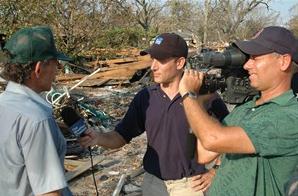
Webcam of front yard in Joplin during tor
http://www.youtube.com/user/Wiredtylle
Joplin tor
http://www.youtube.com/watch?v=cCsa9dBYSh8
Joplin damage
http://www.youtube.com/watch?v=zh-U3pN2u-4
Brunei waterspout
http://www.youtube.com/watch?v=N4OVISq_5Z4
Joplin damage from the air
http://www.youtube.com/watch?v=8FKD1389bWo
Timelapse of 5/25 funnel near Memphis
http://www.youtube.com/watch?v=QlzwAeNNd78
5/24 OK wall cloud/tor lapse
http://www.youtube.com/watch?v=o7Cz5ZiPZJI
Levees holding back floodwater in MS
http://www.youtube.com/watch?v=zw-AV7CLPS0&hd=1


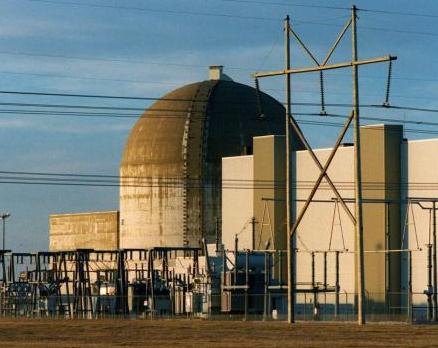
Tornado Alley Reactor Not Fully Twister-Proof. Nuclear reactors are built to withstand the impact of a moderate tornado, not the 200-250 mph EF-5 weather beast that slammed into Joplin a week ago today. USA Today has the story: "WASHINGTON (AP) — The closest nuclear power plant to tornado-ravaged Joplin, Mo., was singled out weeks before the storm for being vulnerable to twisters. Inspections triggered by Japan's nuclear crisis found that some emergency equipment and storage sites at the Wolf Creek nuclear plant in southeastern Kansas might not survive a tornado. Specifically, plant operators and federal inspectors said Wolf Creek did not secure equipment and vehicles needed to fight fires, retrieve fuel for emergency generators and resupply water to keep nuclear fuel cool as it's being moved. Despite these findings, the Nuclear Regulatory Commission concluded that the plant met requirements put in place after the Sept. 11 attacks that are designed to keep the nuclear fuel cool and containment structures intact during an emergency."

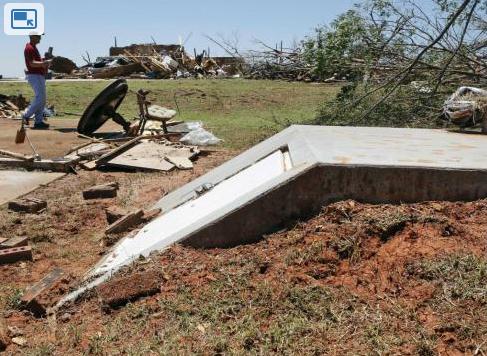

"MYTH: The sky always turns green before a tornado.
REALITY: Sometimes, but not always. A severe thunderstorm contains lots of water, either in the form of rain or hail, and water tends to scatter reddish light. When a storm strikes suddenly, in an otherwise clear sky, sunlight traveling through the atmosphere loses its blue wavelengths first and then the red wavelengths as it passes through the storm. That leaves only the middle part of the spectrum, which is green or greenish.MYTH: Tornadoes strike only in so-called Tornado Alley.
REALITY: It's true that most tornadoes rip through the wide open plains from Texas to Minnesota, but they can hit elsewhere, too. Hurricanes have been known to spawn tornadoes in Florida, and a waterspout - essentially a tornado on water - touched down near Honolulu's Pearl Harbor earlier this month.
MYTH: Tornadoes are more likely to strike mobile home parks than other areas.
REALITY: Not true, but the statistics are grim: People who live in mobile homes or trailers are 15 times more likely to die in a tornado than those who live in permanent housing, according to the Times.
Still, the overall risk of dying in a twister is just 1 in 5 million. The death rate is nine times less than it was before 1925, when tornadoes killed 695 in Missouri, Illinois and Indiana. The tragedy prompted more public awareness, better alerting systems and stronger building designs."* One correction in the story: the safest place in your basement (statistically) is under the stairs, closer to the center of the basement, under a work bench or heavy table, if possible, to lessen the risk of being buried under falling debris.
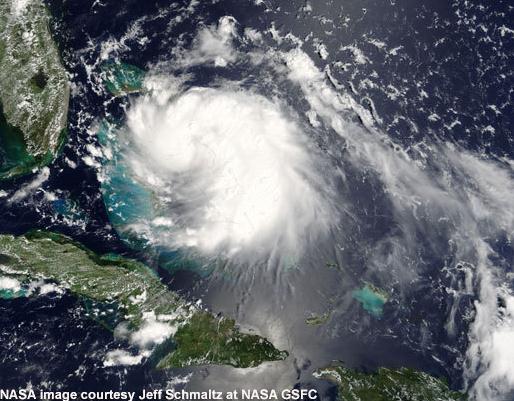

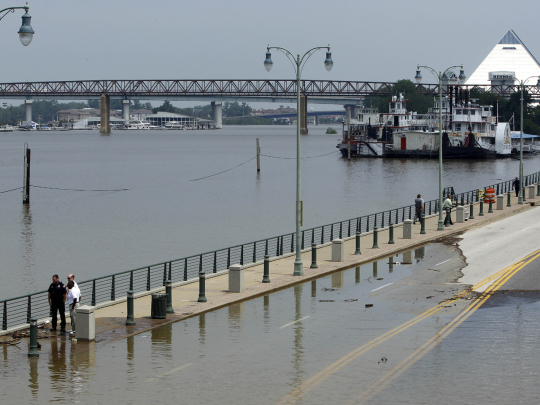
A New Flood, Some Old Truths. An Op-Ed from the New York Times: "The question the environmental community and many in Congress are asking is whether this would have been necessary if the river had been better managed. In populated areas, levees were a necessary response to the cataclysmic floods of the 1920s. But some were built solely to attract more development, while others closed off flood plains that could have acted as a natural safety valve. Meanwhile, over the years, the upper Mississippi watershed has lost millions of acres of wetlands that could have served as a natural sponge for floodwaters. Some experts also believe that dikes, jetties and other structures designed to channel the river and speed navigation have also helped raise water levels to dangerous levels. So-called 100-year floods seemed to be hitting the Mississippi with scary regularity — a $16 billion flood in 1993, a bad one in 2001, another in 2008, and now this one. Climate change, which some suspect of causing torrential downpours, may be part of the problem, though the connection is unclear. What is clear is that we should learn from our mistakes, let nature help out where it can, and not build or farm in places where it makes no sense to do so. As the saying goes: Nobody ever beats the river."


Saturday Numbers. The sun was out part of the day, enough for a high of 75 at Rochester, 72 at St. Cloud and 70 in the Twin Cities. Rainfall amounts ranged from .75" at International Falls to .30" in the Twin Cities, only .01" at Rochester.

Paul's Conservation Minnesota Outlook for the Twin Cities and all of Minnesota:
TODAY: Partly sunny, slight risk of a strong/severe storm by late afternoon. Winds: E 8-13. High: near 70
SUNDAY NIGHT: A few T-storms likely, best chance southern MN. Low: 59
MEMORIAL DAY: Warm and humid, few severe storms? Winds: SE 15-25. High: 84
TUESDAY: Partly sunny, breezy, turning cooler & less humid. Low: 61. High: 74
WEDNESDAY: Lot's of sun, lukewarm breeze - very nice. Low: 50. High: 77
THURSDAY: Less sun, late T-storms (best chance south/west of MSP). Low: 56. High: 78
FRIDAY: Wet start, hazy sun, warmer. Low: 60. High: 81
SATURDAY: Hazy sun, feels like summer! Low: 62. High: 86
SUNDAY (June 5): Plenty of hot sun. High: 85-90

Better Than Average
Is this really a Memorial Day holiday weekend? It looks too sunny out there, too nice to be a holiday. Welcome to the first mostly-nice Memorial Day weekend since 1867. I'm making that up, but it sure SEEMS that way.
Yesterday's "popcorn" instability showers and T-storms have dissipated - enough dry, Canadian air filtering south for a sun-scrubbed sky much of today, especially over the northern half of Minnesota; highs from 67-72. Not bad. A frontal boundary lurking just to our south may ignite a few strong/severe T-storms over parts of southern Minnesota by late afternoon or evening. The severe risk will escalate Monday as the front surges north, highs pushing into the 80s with a drippy dew point above 60. Throw in moderate instability and ample wind "shear" and you have many of the ingredients necessary for a few severe storms again Memorial Day; best chance central Minnesota. That's the thing about severe T-storms and tornadoes. They're fickle, unpredictable riddles. We can see floods & hurricanes coming, have days to prepare. With tornadoes we can only tell when conditions are ripe & track them after they've formed.
Good news: the risk of becoming a tornado victim are 1 in 5 million. You have better odds of winning the Lotto.
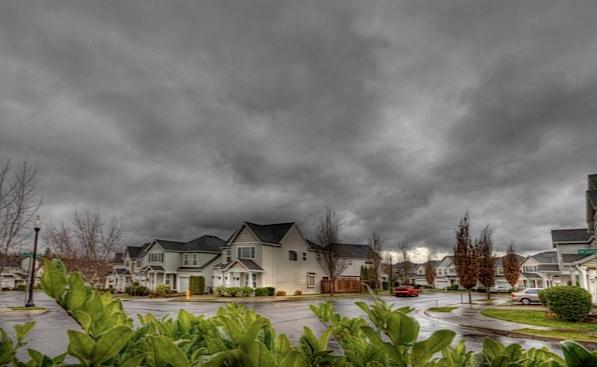
Tornadoes, Climate Change, And Real Scientific Literacy. A story at boingboing.com nails one of the major problems with America's resistance to accepting climate science: they fundamentally misunderstand the way science works. In a world of "yes-no" questions and answers any semblance of gray automatically translates into a resounding "NO". And that's a dangerous way to approach the escalating climate challenge: "When weather-related disasters happen, the first thing most people want to know is whether the disaster was caused by global climate change. And there is more riding on the answer than just another statistic to remember. These tornadoes have been painful. The destruction they've caused is visceral. If this is what climate change looks like, then maybe Americans will be forced to look at decisions about climate-related energy policies in a new light. On the other hand, if the tornadoes of 2011 aren't caused by climate change, then maybe climate change isn't such a big deal. What can we do to us that nature isn't already doing? The trouble with looking at disasters this way is that tornadoes do not fit neatly into little, politically polarized ticky boxes. Science, in general, seldom works like that. In a May 23rd editorial for the Washington Post, environmentalist Bill McKibben took Americans to task for refusing to make a connection between environmental disasters--including the 2011 tornadoes--and climate change. His basic message: All these disasters must be connected and only willful ignorance allows us to ignore that. I have a slightly different perspective. What we have here is not a failure to communicate and accept the obvious effects of climate change. Instead, it's a failure to communicate and accept a critical point of how science works, without which scientific literacy is reduced to mere talking points. This is about nuance and uncertainty, and if the American public doesn't get those things, then we'll never get climate change. When scientists study climate they aren't really studying just one thing. Climate is a complex system, involving multiple natural subsystems and many variables--both "natural" and man-made--that can alter the way those systems work. This is such a complicated subject that we really only developed the computer processing power necessary to start making any sense of it in the mid 1970s. What scientists have learned since then is vitally important stuff. The Earth, as a whole, is warming as humans pump more and more greenhouse gases into the atmosphere. And those rising global temperatures, and rising carbon dioxide concentrations, will affect our lives in a variety of strange, and often surprising, ways. This is the science that should be influencing the way we plan for the future. But it's not. Not really. And I think the reason why has a lot to do with how science is taught to the vast majority of Americans, the people whose science education really ends along with the end of high school."

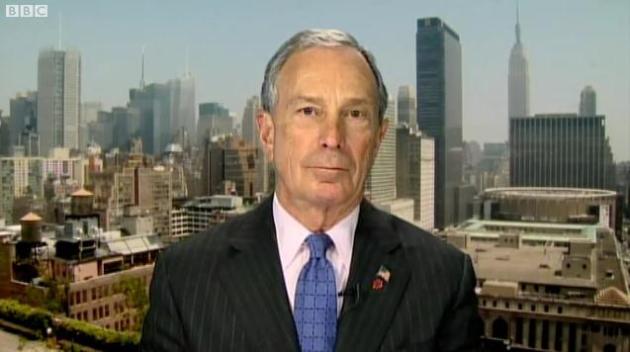
Michael Bloomberg: Too Much "Hot Air" On Climate Change. The story from the BBC: "New York City Mayor Michael Bloomberg has accused politicians in the United States of a failure of leadership when it comes to dealing with climate change. Mr Bloomberg told the BBC that legislators at the state and national level were full of "hot air" because they preferred to put off decisive action for decades. He was speaking ahead of a conference of mayors from 40 international cities to be held in Sao Paulo, Brazil, next week. Mr Bloomberg said elected officials at the local level have to lead the way by improving energy efficiency, reducing pollution and preparing cities for more extreme weather."

Forget Facts, It's Personality That Rules Reactions To Climate Change. A very interesting perspective from the Sydney Morning Herald. Now we have to bring psychologists into the mix to help people cope with the implications of climate change. Yes, on some level climate-denial is easier. Just close your eyes, cover your ears, hope you won't be around long enough to see the worst implications of a warmer, drier, more extreme climate: "The report is a powerful enunciation of what science now knows about climate change and the risks it poses. That the atmosphere and the oceans are warming, ice is being lost from glaciers and ice caps, sea levels are rising and the biological world is changing. ''We know beyond reasonable doubt that the world is warming and that human emissions of greenhouse gases are the primary causes.'' In the nuanced language of science, it doesn't get much stronger. As the American scientist Naomi Oreskes has observed, ''History shows us clearly that science does not provide certainty. It does not provide proof. It only provides the consensus of experts, based on the organised accumulation and scrutiny of evidence.'' And here we have it. So how do you respond to such confronting news? Do you weigh the credentials of the speakers, study the evidence? Or do you switch it off, turn the page, scream and shout? According to psychological research by the Cultural Cognition Project at Yale University, your reaction either way will have little to do with the strength of the arguments or the calibre of the science. It will have everything to do with whether it gels with, or offends, your deep-seated views about morality and how the world ought to work. Yale law professor Dan Kahan's ''cultural cognition of risk'' theory attempts to explain public disagreement about the significance of empirical evidence by plotting individuals on two scales of cultural belief: individualists versus communitarians, based on the importance people attach to the public good when balanced against individual rights; and hierarchists versus egalitarians, based on their views of the stratification of society. Simply explaining the science to these audiences, he finds, will only serve to wedge the two sides."
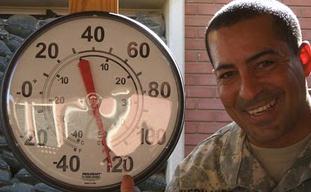
Study Shows Local Temperature Influences Belief In Global Warming. Ridiculous to look at the thermometer outside your window and make assumptions about the entire planet? Absolutely, and yet it appears that human beings are hard-wired to do just that, according to a recent study from the Columbia Business School, as reported by eurekaalert.com: "NEW YORK – May 27, 2011 – A study by Columbia Business School Professor Eric Johnson, co-director of the Center for Decision Sciences (http://www4.gsb.columbia.edu/decisionsciences) at Columbia Business School, Ye Li, a postdoctoral researcher at the Center for Decision Sciences, and Lisa Zaval, a Columbia graduate student in psychology, found that those who thought the current day was warmer than usual were more likely to believe in and feel concern about global warming than those who thought the day was unusually cold. The study, recently featured in Psychological Science, explains why public belief in global warming can fluctuate, since people can base their thinking off of the day's temperature. The researchers behind this study are also affiliated with Columbia University's Center for Research on Environmental Decisions, CRED (http://www.cred.columbia.edu/). The team surveyed about 1,200 people in the United States and Australia in three different studies in order to determine their opinions about global warming and whether the temperature on the day of the study was warmer or cooler than usual. Respondents who thought that day was warmer than usual were more concerned about global warming than respondents who thought that day was colder than usual. "Global warming is so complex, it appears some people are ready to be persuaded by whether their own day is warmer or cooler than usual, rather than think about whether the entire world is becoming warmer or cooler," said lead author Ye Li. "It is striking that society has spent so much money, time and effort educating people about this issue, yet people are still so easily influenced." The study also revealed that respondents were fairly good at knowing if it was unusually hot or cold--perceptions correlated with reality three quarters of the time. While politics, gender and age all had the predicted influences – for instance, on the researchers' 1-to-4 scale of belief in global warming, Democrats were 1.5 points higher than Republicans – after controlling for the other factors, the researchers found that perceived temperatures still had nearly two-thirds the power as political belief, and six times the power as gender. These results join a growing body of work that shows how irrelevant environmental information, such as the current weather, can affect judgments and opinions on climate change."
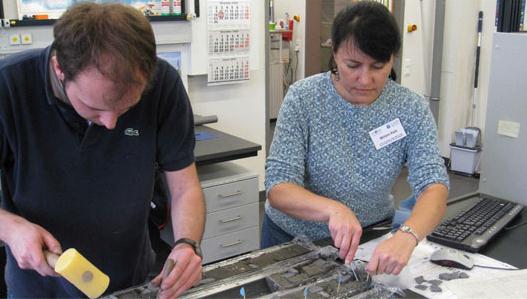
Ocean Currents' Effect On Climate Change. Mother Nature Network has the story:
"Scientist Mimi Katz looks at core samples; she will later identify microscopic plankton fossils. These fossils will provide data about ocean trends over 30 million years ago. (Photo: Mimi Katz/RPI) Scientists may be closer to figuring out why the tropical forests that once covered the American Midwest more than 30 million years ago have now turned into cornfields. And it all has to do with the temperature of the oceans. According to a new study, the Antarctic Circumpolar Current (ACC) is believed to be responsible for these shifts in the world’s climate, and for longer than was originally believed. Oceans and global temperatures are connected as warm waters create warmer temperatures and vice versa. As water temperatures cool, so did the climate around the world, resulting in changes to landscapes. The ACC is often considered the “mixmaster” of the oceans, as it redirects warmer waters back to the northern Atlantic Ocean. This redirection of water over time is responsible for the four-layer ocean current and the heat distribution system. "What we have found is that the evolution of the ACC influenced global ocean circulation much earlier than previous studies have shown," said Rensselaer Polytechnic Institute scientist Miriam Katz, who led the study."

When Global Warming Becomes "Weather". Are storms really becoming more extreme? Coincidence, fluke or a troubling trend? Robert Miller from newstimes.com attempts to connect the dots: "People say we can never connect weather to climate change,"' said Michael Mann, director of the Earth System Science Center at Penn State University. "It's almost like a mantra. It's technically true. But it's not just very useful. "It's as if you were rolling loaded dice and the guy who loaded them was cleaning your clock. "He could say `You can't prove any individual throw had anything to do with loaded dice.'" What climate scientists have been saying for a long time is that as the atmosphere heats up, what will happen is not that the northern climes will enjoy year-round tropical breezes and languid temperatures. It's that they'll see more storms, bigger storms and more erratic weather swings. That's because as things warm up, there will be more moisture in the atmosphere. More moisture means more rain or in the winter, more snow. "Warmer air can hold more moisture,'' said Brenda Ekwurzel, climate scientist for the Union of Concerned Scientists. "It's like getting off a plane in Florida after you've been in Connecticut. "You can just feel that moisture.'' Ekwurzel said the US Global Change Research Project has looked at the heavy storms -- lots of rain, lots of snow -- from 1958 to 2007. It found that in the eastern United States from West Virginia to Maine, those storms had grown worse by 67 percent over the years. Nationwide, Ekwurzel said, big storms have gotten bigger by 20 percent. "It's happening now,'' she said of the effects of climate change on our weather.
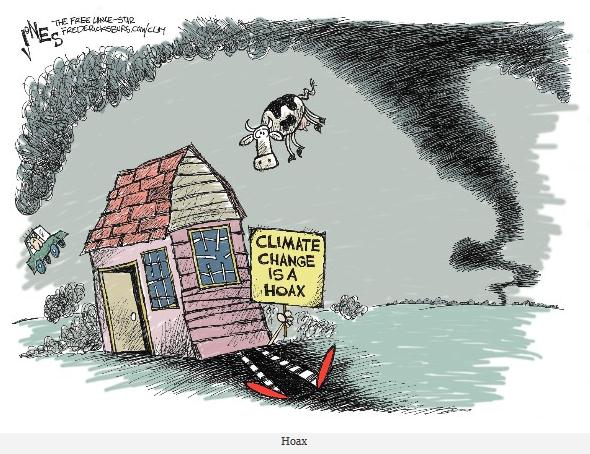
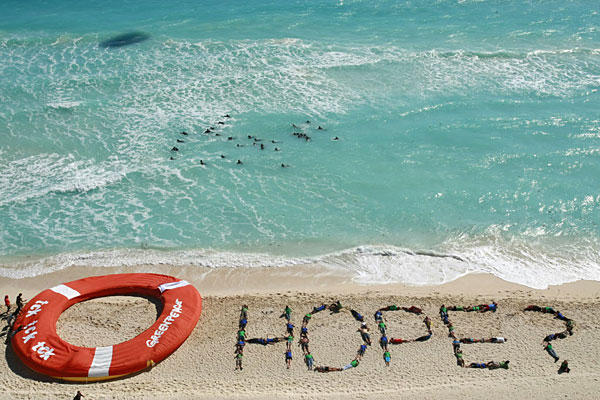
Climate Change Is Happening - Deal With It. A poignant editorial in the Standard Examiner: "Patterns of extreme weather are caused by climate change. And 100-year floods every decade and devastating tornadoes don't care what you think about Al Gore's PowerPoint presentations. Unless you own stock in an oil or coal company, still doubting the glaciers are disappearing is denying against your own interest. The weather doesn't care if you believe in global warming, don't believe in global warming or do but don't think it's caused by human activity. Weather kills indiscriminately, regardless of opinion. According to reports, despite any climate change deniers, FEMA is still preparing for more floods and bigger hurricanes. Which, dare I say it, is smart government planning: Listen to scientists. Because there is no global warming "debate." There's consensus among scientists (people whose job is to study the big picture of climate) - and then there are others who for whatever reason just say "nu-uh." A debate is when two sides each have a plausible case to present: A Middle East peace plan is a debate; a solution to our unmatched incarceration rate is a debate; a strategy for a more effective education system is a debate. Global warming denial is like closing your eyes to make your opponent disappear."
No comments:
Post a Comment